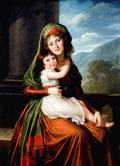 June 5 - August 8, 1982
|
|
| |||
AND HER DAUGHTER, 1793 Oil on canvas 53 1/2 x 39 inches (136 x 99 cm) Signed and dated lower left: L. E. Vigee / Le Brun a / Vienne 1793 The University of Arizona Museum of Art. The Samuel H. Kress Collection This is the first portrait of a mother and child executed during Vigee Le Brun's twelve years of exile. The pose is reminiscent of the artist's two paintings of herself with her daughter of 1786 and 1789 (fig. 24 and 26), which in turn were inspired by Raphael's Madonna della sedia. The most unusual aspect of the Schonfeld portrait is the sharply contrasting green and red hues of the mother's costume. Ursula Margaretha Agatha Victoria, Countess von Schonfeld (1767-1805), wife of the Saxonian ambassador to the Hapsburg court, was the daughter of the "Reichsgraf" Johann Fries, a Viennese banker native of Mulhouse. The artist tells an amusing anecdote about her snobbish sitter. Her mother was passionately fond of the theater and occasionally invited Vigee Le Brun to attend amateur performances given in her palace in Vienna: "... the Countess de Schoenfeld was very pretty and as fashionable as could be. One day her mother... gave a role to a nephew of hers who looked very undistinguished. As I was seated next to Mme de Schoenfeld, I asked her who this gentleman was. -'He is my mother's nephew,' she replied, unable to bring herself to say 'He is my cousin' (Souvenirs, II, 217). Vigee Le Brun received two other commissions from the wealthy Fries family. She painted a pastel portrait of Countess von Schonfeld's young brother Count Moriz Fries (1777-1826), the future banker and art collector, and a knee-length portrait in oils of her sister Sophia, the future Countess Haugwitz, playing a lyre in the role of Sappho (now in the National Castle Museum of Jaromerice, Czechoslovakia). Both of these portraits were engraved by Johann Keller. PROVENANCE: Von Schonfeld collection, Vienna; by inheritance to the sitter's great-niece, Frau Dumba, Vienna (painting proposed to the Louvre in 1932 by her husband, Dr. Theodor Dumba); with Knoedler, New York as of 1940; with Jacques Seligmann & Co., New York; acquired from Seligmann by the Kress Foundation, 1950; sent to The University of Arizona Museum of Art, Tucson, 1951. MAJOR EXHIBITIONS: New York, World's Fair, Masterpieces of Art, 1940, no. 225, illus.; Washington, D.C., National Gallery of Art, Exhibition of Art Treasures for America from the Samuel H. Kress Collection, December 10, 1961- February 4, 1962, no. 100. SELECTED REFERENCES: Souvenirs, II, 372; W. Suida, Paintings and Sculpture from the Kress Collection, Washington, 1951, no. 1 ' 04; C. Eisler, from the Samuel H. Kress Collection, European Schools, London, 1973, p. 362, no. K1711, illus. fig. 329.
|
|
Kimbell Art Museum, Fort Worth, Texas.
Web Site Designed and Maintained by |
